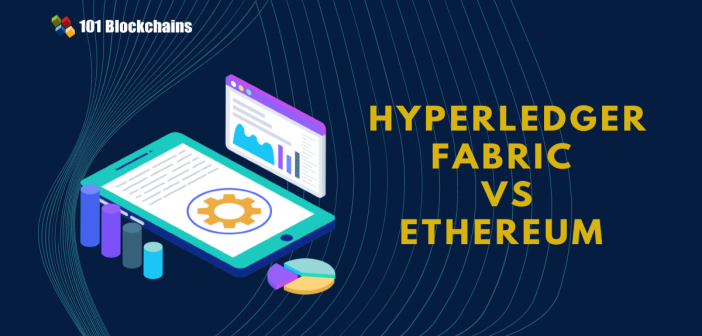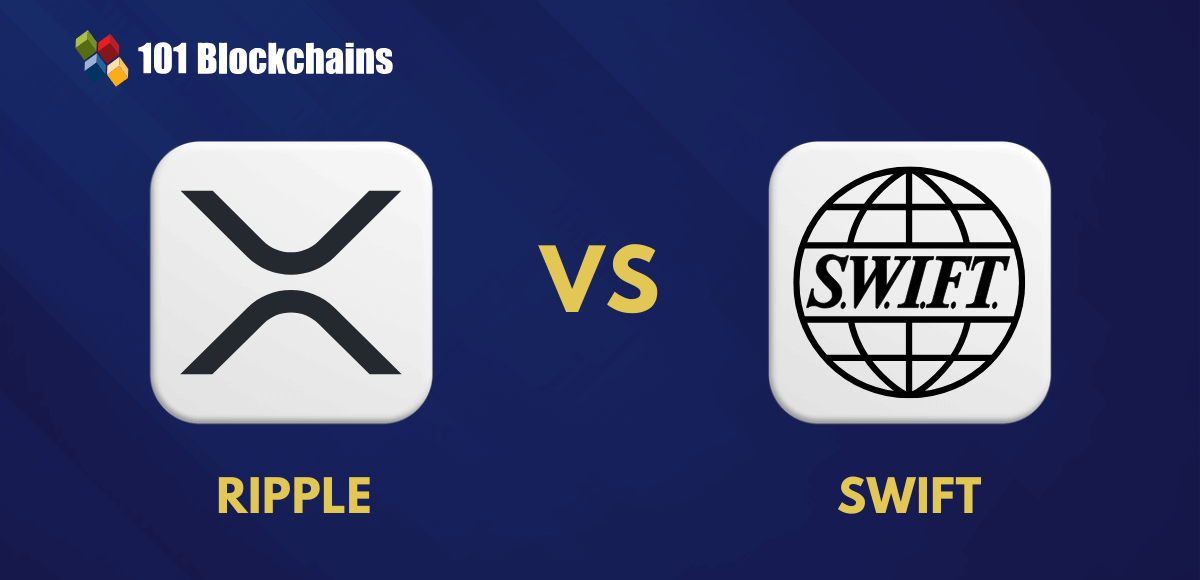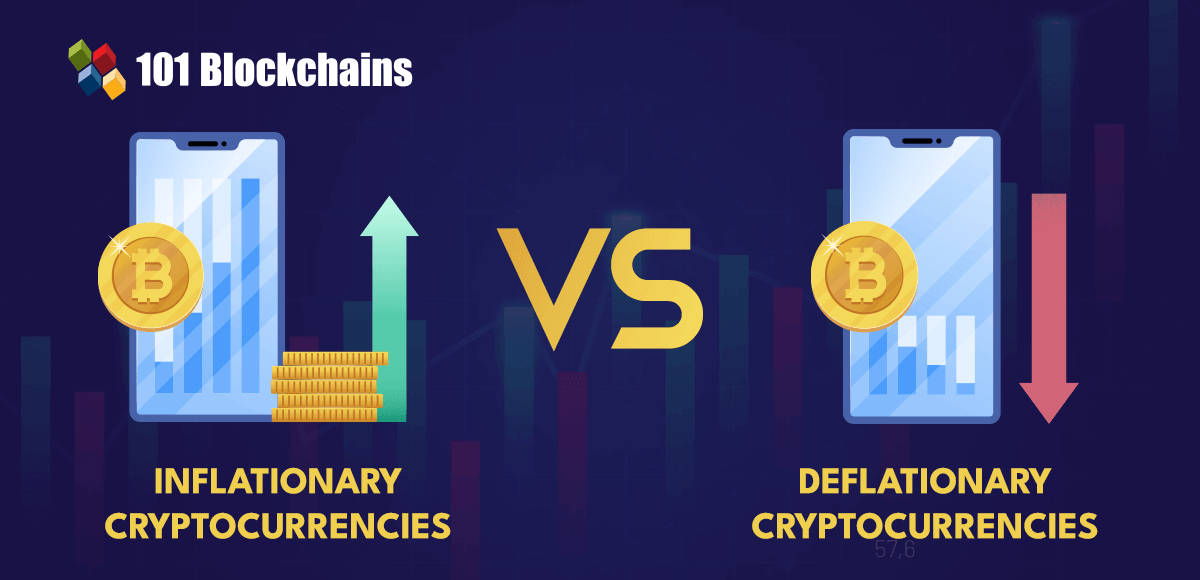Learn how blockchain truly works, master key definitions, and uncover what makes smart contracts so "smart." Dive into the fundamentals, gain valuable insights, and start your blockchain journey today!

Comparisons
Gwyneth Iredale
on February 12, 2021
Hyperledger Fabric Vs Ethereum: Head-To-Head Battle
This article compares the two most popular blockchain platforms — Hyperledger Fabric and Ethereum, along with the basic concepts of these two platforms.
The need for blockchain technology keeps rising, and many of the platforms are going mainstream. Among these, enterprises are more than ever eager to go for blockchain solutions, and they are willing to put a considerable amount of resources into that. Platforms like Hyperledger Fabric and Ethereum are already making headlines every day. That’s why it’s necessary that we cover Hyperledger Fabric vs Ethereum comparison.
Both of these platforms are hugely famous for their unique structures. More so, both offer a lot of features that can change or reshape the way of our business models. But how do they do in comparison? Can one outrun the other? Well, we can only find that out in this Hyperledger Fabric vs Ethereum guide.
Excited to build your skill in Ethereum development by leveraging the ethers.js library? Enroll Now in Ethers.Js Blockchain Developer Course!
Please include attribution to staging2.staging2.101blockchains.com with this graphic. <a href='https://staging2.staging2.101blockchains.com/blockchain-infographics/'> <img src='https://staging2.staging2.101blockchains.com/wp-content/uploads/2020/01/Hyperledger-Fabric-Vs-Ethereum.png' alt='Hyperledger Fabric Vs Ethereum='0' /> </a>
What is Hyperledger Fabric?
First of all, let’s start with their basic introduction. If you are just a beginner in the enterprise blockchain field, it’s best to read this part as you’ll get a solid idea of what these two are. First of all, Hyperledger started its journey back in 2015. At that time, blockchain technology already started to grab the attention of the big players. However, there weren’t any platforms suited for enterprise use cases.
Enter Hyperledger. Anyhow, it was the perfect time to help the community grow and reach the full potential it has. Hyperledger Fabric is one of the popular projects of the umbrella company Hyperledger Blockchain. There are many other projects and frameworks, as well. But Hyperledger Fabric did catch everyone’s eye as soon as it went live. Together with IBM, the Linux foundation developed the Fabric framework.
Just like any other platform, it comes with ledgers, smart contracts, and protocols that help all the users take part in the transaction process. However, there’s a significant difference between Hyperledger Fabric architecture and other blockchain architecture. Basically, Hyperledger Fabric architecture is permissioned and private. So, it won’t allow just any user to get access to the network. In Hyperledger Fabric architecture, you have to be a member of the network, and by then, you can get access to the system.
Want to learn the basic and advanced concepts of Blockchain and Hyperledger Fabric? Enroll Now: Getting Started with Hyperledger Fabric Course
Suited for Enterprises
As you can see, it’s a perfect solution for any enterprise company. Enterprises need their privacy and can’t rely on public platforms to do that. Why? Well, because there is much sensitive information in enterprise companies that they can put out for display for their competition in the market. It just won’t be beneficial in any way. Thus, Hyperledger Fabric architecture having their backs can really help them utilize all of the benefits of the technology and still preserve their integrity.
In reality, Hyperledger Fabric consensus is actually a flexible model. Additionally, it comes with a wide range of consensus algorithms, pluggable options, multiple ledger formats, and many more. As you can see, you can customize this platform to a great extent. Thus, it’s very effective to implement blockchain solutions for any kind of industry.
Another cool feature of Hyperledger Fabric architecture is that it lets you create separate channels that can offer private transaction options. You can’t access this without the proper level of access.
Start your blockchain journey Now with the Enterprise Blockchains Fundamentals
Benefits of Hyperledger Fabric
There are some primary benefits of technology. According to their documentation, this technology is more than capable of handling the load of traffic that enterprises get every day. Thus, features like open-source, modular design, high efficiency, applications, and quality code make it even more lucrative.
Let’s see what these are –
-
Open-Source
Well, the best part about Fabric is that the platform is open-source. That means that anyone can use the platform to benefit their company. Furthermore, they don’t ask for any kind of money to use on your projects. So, if you have a great in-house team of developers, you can easily build a platform around it, and you won’t have to pay Hyperledger for it. However, as in many cases, the enterprises need more features or need it to be geared for their industry only.
Thus, only getting ahold of the source code isn’t enough. You’ll need your developers that can understand how it actually works and have the skills to code on top of it. More so, they also need to understand how the Hyperledger Fabric consensus works to find out if those algorithms are enough to safeguard your information. Based on the Hyperledger Fabric consensus, you can add or remove any feature you want.
-
Suitable for Wide-Ranging Industry
The best part about Fabric is that it can go with almost any kind of industry at the moment. Thus, it means, no matter what industry you are from, the Hyperledger Fabric project can surely help you out in that.
Anyhow, industries such as healthcare, supply chain, insurance, media, cybersecurity, IoT, banking, government, real estate, and many others are already using it.
Moreover, many Fabric projects can show you how fast the platform is gaining popularity. As the platform is permissioned, using it in any kind of environment is quite easy.
Build your identity as a certified blockchain expert with 101 Blockchains’ Blockchain Certifications designed to provide enhanced career prospects.
-
Quality Code
Hyperledger Fabric project really comes with a set of quality codes. In every new addition, they make sure that they have the highest quality in the market. But how do they do it? Well, before every launch, they tend to observe their codes for security concerns carefully. More so, they also do vigorous testing on their coding as well.
What it does is that it gets rid of any concerns that may give hackers an option to hack the system. Another cool feature is that Fabric prefers quality over quantity. Also, the code is open-source community developers can easily point out any faults, and they can also quickly patch them up. So, you can always imagine that you are getting the perfect platform every time.
-
Higher Efficiency
According to their documentation, the technology boasts about how they offer more efficiency compared to other blockchains. In reality, the architecture of the technology is what gives it a massive boost in efficiency. More so, all the node within the system comes with different assignments. So, separating transaction processes from other ordering processes really helps to get it done in time.
And so, they can use Hyperledger Fabric consensus to process transactions without ever slowing down the platform simultaneously. Anyhow, not all nodes have the burner to carry out transactions. Thus, they can use their resources to carry out other benefits in the network.
Excited to learn the basic and advanced concepts of ethereum technology? Enroll Now in The Complete Ethereum Technology Course
-
Modular Design
This is by far the most attractive feature of the Hyperledger Fabric project. It’s fully modular. By this, we mean that you can use as many features as you like in the system. So, you can change the Hyperledger Fabric consensus, ledger types, add tokens, add up other functionality, etc. All you have to do is to plug it in and start using it.
For example, you can also have multiple consensuses for multiple reasons such as one for transactions, one for identity, and so on.
Start learning Blockchain with World’s first Blockchain Skill Paths with quality resources tailored by industry experts Now!
What is Ethereum?
According to Ethereum’s documentation, it’s a global and open-source platform for all decentralized applications. In reality, On Ethereum, you can program it to control digital value and can run it from anywhere around the globe. More so, it’ll perform precisely the things you program it to.
First of all, Ethereum started as a public domain right after the boom of Bitcoin’s platform. More so, Ethereum architecture became active in 2015. Vitalik Buterin is the founder and core programmer of the platform. Check out this article to know who is Vitalik Buterin of Ethereum. You can think of it as a programmable version of blockchain technology. For example, just imagine that you have the skeleton of the technology, and you can make changes as much as you want in that. So, all you have to do is to add the functionalities, layer your security protocols, and cryptographies, and you get a full-functioning solution all to yourself.
Thus, there are a vast number of centralized applications out there that are built on top of the Ethereum architecture skeleton. However, it’s a public platform. As a result, enterprises where’s willing to use this technology from the start. Why though? Well, it’s because they need privacy and it can’t possibly offer it.
Ethereum consensus mechanism uses an upgraded version of the Proof of Stake algorithm. In reality, the Ethereum consensus mechanism is quite robust and efficient. However, the issue is it takes up a lot of resources and can slow down.
Want to know more about Ethereum development? Ethereum Development Fundamentals
How Does It Work?
For the sake of Ethereum vs Hyperledger Fabric comparison, you have to know the Ethereum actually works in reality. A major of the processes go through the Ethereum Virtual Machine (EVM), which is a Turing-complete software. Basically, what it does is that it executes certain scripts within a distributed network of devices.
More so, it also allows the execution of smart contracts and stores everything from the DAO (what is DAO) to the smart contract regulations. In reality, Ethereum architecture does allow developers to build decentralized applications on top of it. So, that’s why you get a lot of organizations, games, distributed registries, and many other cool apps.
According to their whitepaper, Ethereum architecture offers –
-
Simplicity
Ethereum architecture offers simplicity in its platforms. That’s why all of their protocols are efficient even though it may come with the cost of time inefficiencies or data storage.
-
Universality
The internal Turing-complete script can help developers around the world to program smart contacts for any type of transaction. This promotes its universality.
-
Modularity
Additionally, the Ethereum protocol is in a modular phase. As in, you can separate the functions and add up any other function as you want.
-
Agility
All the Ethereum protocols are not some binding rules that you must follow. More so, the company offers many ways to improve its protocols and make sure they can be scalable.
-
Non-Discrimination
It won’t restrict any user from join in on the transactions. So, as a result, anyone is welcome to enjoy all the benefits of blockchain.
Get familiar with common Ethereum terms with the Ethereum Flashcards
Benefits of Ethereum
There are certain benefits that come with the Ethereum Platform. Let’s see what they are –
- Immutability: it’s evident that you can’t make any changes to the ledger. So, any third-party won’t have access to it even though it’s a public domain.
- Corruption Proof: There no way anyone can perform corrupting activities in the system without anyone noticing it. If anyone tries even to alter any kind of documents, the system will get alerts, and all the users will also get alerts of that.
- Security: In reality, Ethereum comes with a lot of security as its open public platform, everything is transparent. And this transparency does add a layer of security for every single user. It also offers a lot of tactics, such as various forms of cryptography and many more.
- No Downtime: Everything running on the Ethereum network won’t have any downtime. So, applications, smart contacts, transactions won’t face any issues and would always be available to anyone.
Hyperledger Fabric vs Ethereum: The Head-to-Head Battle
As you can see, both platforms do a great job in their respective fields. But they’re both blockchain platforms. So, how do you think they can truly platform for common attributes? Well, let’s check out Hyperledger Fabric vs Ethereum now.
To make it more compelling, we are describing each attribute and how every platform performs in that attribute in the Hyperledger Fabric vs Ethereum comparison.
-
Ledger Type
First of all, let’s start with the ledger type. You will see a definitive difference between both platforms. In reality, Hyperledger Fabric is actually a permissioned platform. So, that means that it’s not for the public eye. Also, it’s basically suited for enterprises, and it can offer the privacy they need.
Thus, it comes with membership arrangements for selecting who can get an entry into the system and who can’t. More so, the company itself will decide who can enter the platform.
On the other hand, Ethereum is a public platform. So, there is no form of privacy there. Users in the system won’t have to pass any membership rules in order to get access to the network. Thus, it’s not entirely suited for enterprises.
Let’s move to the next attribute in this Hyperledger Fabric vs Ethereum comparison.
Not sure how to build your career in enterprise blockchains? Enroll Now in How to Build Your Career in Enterprise Blockchains Course
-
Governance
Linux Foundation is the governing entity behind Hyperledger Fabric. However, they also took a major contribution from IBM. So, you can say it’s a product of a massive collaboration that came to be a huge success. Anyhow, some of you may even know it as IBM blockchain. However, both of them are on the same platforms.
On the other hand, Ethereum developers are behind the governing entity of the Ethereum platform. Vitalik Buterin is the main programmer and founder of Ethereum. As you can see, the platform isn’t a product of collaboration among other companies but a more in-house development.
Let’s move to the next attribute in this Hyperledger Fabric vs Ethereum comparison.
-
Industry Focus
In this Hyperledger Fabric vs Ethereum comparison attribute, you’ll find a lot of similarities. In reality, the Hyperledger Fabric project is suited for cross-Industry development. What does it mean? Well, it means that you can use it in any kind of industry. Practically, the company developed this platform that you can harness in any kind of scenario.
Practically, experts first believed blockchain is only suited for the financial sector. But it can be so much more. On the other hand, Ethereum also focuses on cross-industry development. But as its public rather than using it as the internet networking system of the enterprise. Companies can use it to offer a platform for their customers.
However, the new Enterprise Ethereum is more devoted to enterprise-centric applications.
Let’s check out the next attribute in this Hyperledger Fabric vs Ethereum comparison.
-
Throughput
It’s time to get into more details in the Hyperledger Fabric vs Ethereum comparison. Both of the technologies boats about being fast and offering a lot of transactions per second. However, Hyperledger Fabric wins this round. In reality, it comes with > 2000 tps. So, you can expect it to process 2000+ transactions every second.
More so, the Fabric can achieve this score because it offers parallel transactions, and it does limit the user are in the system, so it doesn’t slow down. On the other hand, Ethereum, with a small number of nodes, can pull off a large number of transactions. But as it’s a public domain, it slows down and can now offer something close to 20 tps. This is a massive difference between these two.
Let’s move to the next attribute in this Hyperledger Fabric vs Ethereum comparison.
-
Cryptocurrency
It’s another major difference between Hyperledger Fabric vs Ethereum. In reality, the platform Fabric doesn’t have any native token or cryptocurrency in the system. So, you won’t need to have cryptocurrency in order to use the platforms. However, if a company needs a token-based system, they can easily add it up. So, they won’t be forced to use any native currencies. That’s a huge benefit.
On the other hand, Ethereum comes with a native cryptocurrency called Ether (what is Ether?). More so, there’s another form of token called Gas in the system that you need to perform the transactions in the system. The issue is the price of Gas keeps changing, and with more users, it can become a huge burden as well.
Let’s check out the next attribute in this Hyperledger Fabric vs Ethereum comparison.
Want to become a Cryptocurrency expert? Enroll Now in Cryptocurrency Fundamentals Course
-
Consensus Mechanism
Anyhow, the consensus mechanism of both technologies is different. In reality, the Hyperledger Fabric project does offer a lot of consensus mechanisms to choose from. Anyhow, natively, it uses the Kafka consensus algorithm. However, there’s also Solo and Raft protocols in the mix. More so, Solo is basically more suited for developers, and Raft is crash-fault tolerance.
On the other hand, the Ethereum consensus mechanism uses an upgraded version of the Proof of Stake algorithm. In reality, the Ethereum consensus mechanism is quite robust and efficient. However, the issue is it takes up a lot of resources and can slow down.
But, Ethereum consensus mechanism PoW is a bit more superior to the Raft protocol.
Let’s move to the next attribute in this Ethereum vs Hyperledger Fabric comparison.
-
Smart Contracts
In this one, Ethereum first came up with the concept of smart contracts. It’s actually an actionable contract system that can automate the process of any contracts between parties. More so, the smart contract in Ethereum is quite efficient, and it did become popular in a very short amount of time.
On the other hand, the Hyperledger Fabric also offers smart contracts, but here it’s known as Chaincode. Basically, it’s the business logic of the technology, and it does follow a slightly different process compared to Ethereum smart contracts. Nevertheless, both technologies offer this feature.
Let’s check out the next attribute in this Ethereum vs Hyperledger Fabric comparison.
-
Smart Contract Language
Next, for Ethereum vs Hyperledger Fabric, you’ll get different coding languages for smart contracts. In reality, Ethereum uses Solidity to code smart contracts in the system. Anyhow, Solidity is relatively new and is quite easy compared to other popular programming languages.
On the other hand, Hyperledger Fabric offers Golang, Java, and Node.JS for their version of the smart contracts. So, if you know any of the codes, you can easily develop a smart contract mechanism. Java is a popular programming language, which makes it much easier for developers.
Let’s move to the next attribute in this Hyperledger Fabric vs Ethereum comparison.
Curious to understand the complete smart contract development lifecycle? Enroll now in Smart Contracts Development Course Now!
-
Application Type
This is the last attribute of the Ethereum vs Hyperledger Fabric comparison. Anyhow, both of the parties are suited for a wide-ranging of applications in the real world. In reality, Ethereum is mostly popular for decentralized applications, and that’s why there are thousands of applications on top of Ethereum.
Hyperledger Fabric project, on the other hand, is fairly new, and it does have decentralized applications as well, but not as vast as Ethereum. However, Hyperledger excels in real-world enterprise-grade applications compared to Ethereum.
Ethereum vs Hyperledger Fabric: The Comparison Table
| Ethereum | Hyperledger Fabric | |
|---|---|---|
| Ledger Type | Permissionless | Permissioned |
| Industry-focus | Cross-Industry | Cross-Industry |
| Governance | Ethereum developers | Linux Foundation |
| Cryptocurrency | Ether (ETH) | None |
| Consensus Mechanism | Proof of Stake (PoS) | Pluggable Mechanism |
| Throughput | ~ 20 tps | > 2000 tps |
| Smart Contract | ✓ | ✓ |
| Smart Contract Language | Solidity | NodeJS or Golang or Java |
| Application Type | Wide-ranging | Wide-ranging |
Ethereum vs Hyperledger Fabric: Concluding Thoughts
In the end, Ethereum and Hyperledger Fabric are both two very unique blockchain platforms in the market. Additionally, both of them are capable of handling a lot of issues that the centralized system deals with nowadays.
You may think that Ethereum isn’t suited for commercial use cases. However, that’s not entirely true. Ethereum does have a private version of its technology called Enterprise Ethereum under the enterprise Ethereum Alliance. Here, like Hyperledger, many companies come together and work on possible solutions.
In fact, Hyperledger and EEA are already collaborating on a series of solutions just for the sake of enterprises. So, as you can see, both platforms are great options. Thus, it’s up to you to choose the best one out there.
*Disclaimer: The article should not be taken as, and is not intended to provide any investment advice. Claims made in this article do not constitute investment advice and should not be taken as such. 101 Blockchains shall not be responsible for any loss sustained by any person who relies on this article. Do your own research!






